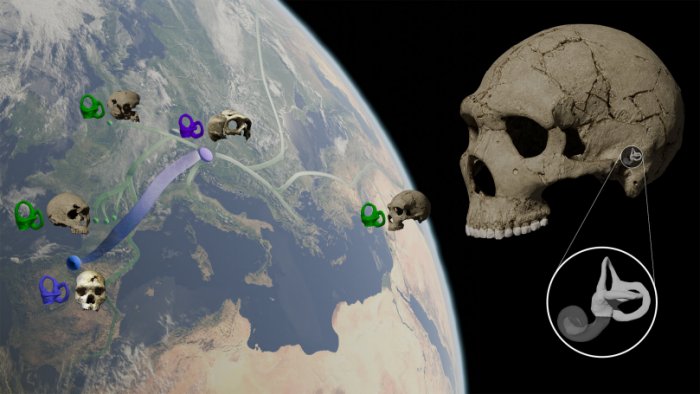Jan Bartek – AncientPages.com – Recent research into the inner ear morphology of Neanderthals and their ancestors offers new insights that challenge the prevailing theory regarding their origins. Previously, it was believed that Neanderthals emerged following an evolutionary event marked by a reduction in genetic diversity. This study draws on fossil samples from Atapuerca in Spain, Krapina in Croatia, and various other sites across Europe and Western Asia.
Artwork on the schematic representation of the distribution of morphological variation of the inner ear along time in Neanderthal lineage. Credit: Alessandro Urciuoli (Institut Català de Paleontologia Miquel Crusafont)
Neanderthals are thought to have appeared approximately 250,000 years ago, evolving from European populations known as “pre-Neanderthals” who lived on the Eurasian continent between 500,000 and 250,000 years ago. Contrary to earlier beliefs that Neanderthal evolution involved no major changes, recent paleogenetic studies using DNA extracted from fossils have identified a significant loss of genetic diversity between early Neanderthals (or ancient Neanderthals) and later ones (commonly referred to as “classic” Neanderthals).
A “bottleneck” is a term used to describe a genetic loss that often results from a decrease in the population size. Paleogenetic evidence suggests that such a decline in genetic variation occurred around 110,000 years ago. Previously, scientists widely assumed that an earlier bottleneck event was linked to the emergence of the Neanderthal lineage.
This led to hypotheses suggesting that early Neanderthals had lower genetic diversity compared to their pre-Neanderthal ancestors due to this bottleneck. However, confirmation of such a bottleneck at the origin of Neanderthals remains elusive because paleogenetic data lacks sufficiently ancient genetic sequences necessary for studying this event through ancient DNA analysis.
In a study led by Alessandro Urciuoli (Institut Català de Paleontologia Miquel Crusafont, Universitat Autònoma de Barcelona) and Mercedes Conde-Valverde (Cátedra de Otoacústica Evolutiva de HM Hospitales y la Universidad de Alcalá), researchers measured the morphological diversity in the structure of the inner ear responsible for our sense of balance: the semicircular canals.
It is widely accepted that results obtained from studying the morphological diversity of the semicircular canals are comparable to those obtained through DNA comparisons.
The study examined two remarkable collections of fossil humans: one from the Sima de los Huesos site in Atapuerca, Burgos, Spain, dated to 430,000 years ago and representing the largest sample of pre-Neanderthals in the fossil record; and another from Krapina, Croatia, which is the most complete collection of early Neanderthals and dates back to approximately 130,000–120,000 years ago.
Researchers assessed the morphological diversity (disparity) of the semicircular canals in both samples. The scientists compared these findings with a sample of classic Neanderthals from various ages and geographical locations. The results indicate that classic Neanderthals exhibit significantly lower morphological diversity in their semicircular canals compared to pre-Neanderthals and early Neanderthals. This observation is consistent with previous paleogenetic studies.
“By including fossils from a wide geographical and temporal range, we were able to capture a comprehensive picture of Neanderthal evolution. The reduction in diversity observed between the Krapina sample and classic Neanderthals is especially striking and clear, providing strong evidence of a bottleneck event,” Conde-Valverde, co-author of the study, said.
On the other hand, the results challenge the previously accepted idea that the origin of Neanderthals was associated with a significant loss of genetic diversity, prompting the need to propose new explanations for their origin.
“We were surprised to find that the pre-Neanderthals from the Sima de los Huesos exhibited a level of morphological diversity similar to that of the early Neanderthals from Krapina,” commented Urciuoli, lead author of the study. “This challenges the common assumption of a bottleneck event at the origin of the Neanderthal lineage,” the researcher stated.
The study was published in Nature
Written by Jan Bartek – AncientPages.com Staff Writer









